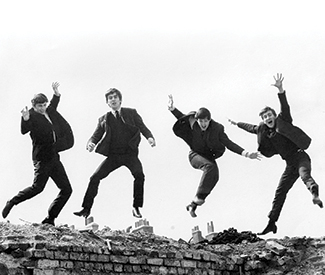arts@sfbg.com
More than any other Beatles album, A Hard Day’s Night — which turned 50 last week — embodies the clichés surrounding the band’s early period. The cheesy harmonies, the “whoa”s and “yeah”s, the sappy love songs: All are there in abundance. It’s also the most obvious manifestation of the John/Paul dichotomy. Though the idea of John as the bad boy and Paul as the balladeer is largely accepted as a myth by Beatles fans, that dynamic is a lot closer to the truth than folks give it credit for, and on no album is it clearer than A Hard Day’s Night.
Paul’s songs are a bit silly, but spectacularly well-crafted. “And I Love Her” repeats the word “love” incessantly, but the twinkling background makes it seem transcendent. You’re more likely to come out of it remembering the four-note guitar riff that frames the song anyway. Better yet is “Can’t Buy Me Love.” The song’s chorus looks absurd on paper (“can’t buy me love/everybody tells me so/can’t buy me love/no no no no”), but it’s so catchy it’s hard not to ignore the lyrics.
John’s love songs are far more bitter and sarcastic. But it’s important to remember that John Lennon was more than just a media-ready “bad boy.” His reputation as a peacenik and a member of the most (supposedly) infallible paragon of pop music in history has sadly clouded his history of alleged neglect and abuse toward his children and various lovers. Knowing the latter gives an unpleasant context to the Lennon songs on this album.
I find “You Can’t Do That” unlistenable for this reason. The song is told from the perspective of a man whose girlfriend has been talking to another boy. He warns her that if he catches her doing it again, he’ll “let her down” and “leave her flat.” It’s hard not to interpret those as a reference to domestic violence, given that Lennon’s first wife, Cynthia, was a victim of such abuse. And the theme of the song evokes Lennon’s own worries concerning his second wife, Yoko Ono, whom he often dragged into the studio out of fears she would abscond with another man if left alone.
Another prominent theme is Lennon’s pride and his fixation on the shame of having had his girl cheat on him. This theme surfaces on “You Can’t Do That” (“if they’d seen you talking that way they’d laugh in my face”). It’s as bad on “If I Fell.” John asks his potential girlfriend if she’d “hurt my pride like her” then bluntly tells her how much he’d enjoy his ex’s misery at seeing the two of them together.
It’s less rational to believe that these songs are told from the perspective of an abuser so much as they illustrate Lennon’s own viewpoint as a real-life abuser. There’s nothing in these songs to suggest he’s playing a role of any sort. On one song, he does. “I’ll Cry Instead” finds Lennon simulating the illogical thoughts that come in the wake of anger and sadness. His girl left him, and he’d like to go out and “break hearts all ’round the world” as revenge, but he can’t, so he’ll cry instead.
The point of this song isn’t that he’d like to hurt her, but that he’s thinking irrationally — he’ll feel better once he’s had a good cry. Thus, I find it easier to separate this song from its creator. Nonetheless, A Hard Day’s Night is one of those albums — at least for me — where art and artist are too firmly entwined for the album not to suffer.
It would be ridiculous to accuse anyone who enjoys this album of being a misogynist. But I would object to anyone denying these issues are present. If these moral questions inhibit you from enjoying the art, so be it. But to dismiss these issues in order to preserve your prior appreciation of the music would be tantamount to ignoring those issues in the first place.
There are two Lennon songs that truly warm my heart on this album. The first, “When I Get Home,” is an ecstatic love song that finds its protagonist rushing home to be with his girl. That he has “a whole lot of things to tell her” suggests he’s actually interested in conversing with the girl, not just having sex. And he’ll love her the next day too, and accordingly make the same voyage. Now that’s love.
Second is the title track. On no other Beatles song is the interplay between John’s voice and Paul’s more effective. It’s difficult to even notice that the vocalist has shifted until the end of the first chorus. But it’s the gradual build in emotion that makes this song so brilliant. By the time the chorus is about to transition back into the verse, Paul is emoting relentlessly — and then in comes the verse again, with John’s dry voice snapping satisfyingly into place and contrasting icily with Paul’s catharsis. This song elevates the album substantially by itself, though A Hard Day’s Night remains my least favorite of the Beatles’ “great albums” (i.e. the ones with only original songs).
Though I generally avoid discussing my own sentimental attachment to albums in reviewing them, I’ll close this review by saying A Hard Day’s Night is by far the most important album in my life. As the first rock album I ever listened to, it ended my 12-year streak of aversion to music due to my sensory processing disorder. But I haven’t gone back to it much — simply because I listened to eight other Beatles albums immediately afterward, and every single one of them puts A Hard Day’s Night to shame.

